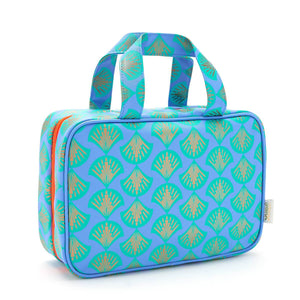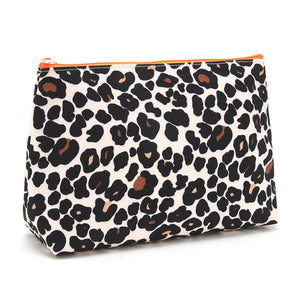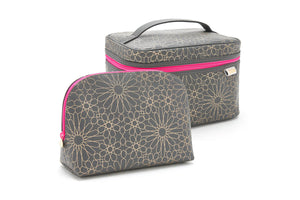Do you know your UVAs from your UVBs? Are you confused as to what SPF to wear? We explain what to look for when it comes to protecting your skin.
Whether you call it sun cream, sunscreen or suntan lotion, we all know it is a must-have to protect our skin throughout the summer months. While we should use sunscreen every day of the year, during the summer, not only are days longer and we spend more time outdoors, but the sun is stronger. Sun exposure is responsible for a whole host of issues including premature aging, skin damage and can even increase the risk of skin cancers, so you certainly don’t want to take any risks. See here what to look for..

Emma 3 in 1 Hanging Wash Bag in Leopard Print SHOP NOW >>
1. Which sunscreen should I use?
We can’t stress how important it is to make sure you are protected from UV (Ultraviolet) radiation. This reaches us in the form of both UVA and UVB rays, two acronyms you are no doubt familiar with. Both are damaging to our skin and have been scientifically linked to skin cancer. But what’s the difference between the two? An easy way to remember is that the A in UVA is for Aging and the B in UVB is for Burning. Let’s look at this in more detail.

UVA rays - A is for aging
UVA rays are around us all throughout the year and are the primary cause of skin damage and premature aging. The UVA rays penetrate deeply into the skin which leads to wrinkles, sunspots, pigmentation and other damages to the skin. It’s therefore important to consider UVA protection not only in high season but as part of your year-round daily skincare.
How to read the UVA label
When shopping for your sun cream, look out for the UVA logo on the bottle. This shows the sun cream meets the EU requirements for how much UVA protection the product gives you.
UVA protection is measured by a star rating from 1-5. This shows how many UVA rays it's blocking, in relation to how many UVB rays. Make sure you choose a sun cream with a 4 or 5 star rating to take the best care of your skin.
UVB rays - B is for burning
UVB rays are what cause our skin to burn and are the main cause of skin cancer. The levels of UVB rays vary, depending on where you are in the world, the time of year and the time of day. Basically, the hotter it is, the more UVB rays there are! UVB light has a much smaller range than UVA and although it’s not as deeply skin-penetrating as UVA rays, UVB light is very powerful, as we all know when we’ve had sunburn.
Protecting against UVB rays is where SPF’s come into play, which brings us onto our next point….
2. What SPF should I use?
According to a British Skin survey, over a third of Brits don’t know what SPF means, so what actually is it? It stands for Sun Protection Factor and refers to the amount of UVB light the sunscreen can filter out. The number tells you how long it will take for your skin to burn, compared to using no sun protection. For example, SP5 30 will protect your skin from burning for 30 times as long as it would without any sun cream.

Higher SPF numbers offer more protection, but the higher you go, the smaller the difference becomes. SPF 15 sunscreens filter out about 93% of UVB rays, while SPF 30 sunscreens filter out about 97%, and SPF 50 sunscreens about 98%.
Good to know: Water resistant” does not mean “waterproof.” No sunscreens are waterproof or “sweatproof’. Products must specify how long it will protect skin for whilst swimming or sweating, but for best protection, you should reapply at least every 2 hours and more if you’re swimming or working out.
3. Think about your skin type
You may also want to pay attention to your skin type as well. Do you have acne, oily, dry or sensitive skin? According to Dr Sam Bunting, cosmetic dermatologist and founder of Dr Sam’s skincare, you should consider the type of filters in your SPF. Physical filters, such as zinc oxide and titanium dioxide, sit on top of the skin and absorb and reflect the UV rays hitting the skin - this is best for sensitive skins. Whilst chemical filters on the other hand are organic carbon compounds that absorb UV rays converting it to heat and keep them from penetrating the skin, which may be better for those with oily skins. Read our blog to find out what beauty products Dr Sam Bunting would pack in her beauty wash bag should she be sent to a desert island in our Desert Island Delights series.
Good to know: a sun cream with SPF 50 and 2 UVA stars provides worse sun protection than a cream with SPF 30 and 5 UVA stars. Also, even sun creams with a low SPF can have a full 5-star UVA rating. This is because the ratio between the UVA and UVB ray protection is the same or similar.
4. How to apply sun cream
In order to gain the most protection from your sun cream, you need to apply it correctly.
Experts recommend using one teaspoon of sun cream per limb and half a teaspoon for the face and neck. Don’t forget those areas that can be easily missed, such as the top of your ears, ankles and feet and use a SPF lip balm to protect your lips.
Make sure you apply 30 minutes before going into the sun and don't forget to reapply every couple of hours and straight after swimming.

Sun protection kit for on the go
If you’re heading out for the day or to the beach or pool, make sure you create a sun protection kit to take with you.
Pack a sun cream for your body and one for your face if you prefer to use different creams. Remember a SPF lip balm and also a UV hair protector if you use one. To ensure your well and truly covered, put a timer on your phone for every 2 hours to ensure you re-apply. Rather than stuff them in a beach bag and risk leaks and greasy marks, we find putting them a small travel beauty bag, such as our Amy 3 in 1 Make Up Wallet keeps them safe and in one place.
'Amy' Travel Makeup Bag in Leopard Tan SHOP NOW >>
5. Other ways to stay sun safe
No sunscreen will completely protect you from the sun. Covering up and wearing protective clothing, including protective swimwear and a wide-brimmed hat, will keep you safe from the sun. Also, try and stay in the shade, especially between the hours of 11:00 and 15:00.
Victoria Green is on a mission to help you #TravelWell. For more tips and advice, read our travel tips in our #TravelWell series of blogs. Did you find this article useful? Leave us a comment below and make sure you share with your family and friends via the buttons below.








